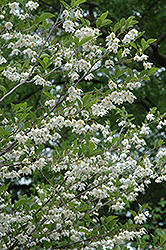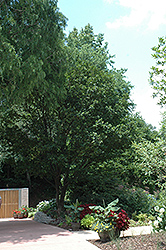Height: 30 feet
Spread: 30 feet
Sunlight:
![]()
![]()
Hardiness Zone: 6b
Other Names: Sohuksan Japanese Snowbell
Description:
A special selection of the species with larger white flowers appearing in early spring; leaves are more robust, a deeper green and leathery; very upright habit; needs moist, organic soil and some shelter, does well in part shade
Ornamental Features
Emerald Pagoda Japanese Snowbell features dainty lightly-scented nodding white bell-shaped flowers hanging below the branches from mid to late spring. It has dark green deciduous foliage. The pointy leaves turn an outstanding yellow in the fall. The fruits are showy gray drupes displayed from late summer to late fall. The smooth khaki (brownish-green) bark adds an interesting dimension to the landscape.
Landscape Attributes
Emerald Pagoda Japanese Snowbell is a deciduous tree with a distinctive and refined pyramidal form. Its relatively fine texture sets it apart from other landscape plants with less refined foliage.
This tree will require occasional maintenance and upkeep, and should only be pruned after flowering to avoid removing any of the current season's flowers. Gardeners should be aware of the following characteristic(s) that may warrant special consideration;
- Invasive
Emerald Pagoda Japanese Snowbell is recommended for the following landscape applications;
- Accent
Planting & Growing
Emerald Pagoda Japanese Snowbell will grow to be about 30 feet tall at maturity, with a spread of 30 feet. It has a low canopy with a typical clearance of 2 feet from the ground, and is suitable for planting under power lines. It grows at a slow rate, and under ideal conditions can be expected to live for 40 years or more.
This tree does best in full sun to partial shade. It requires an evenly moist well-drained soil for optimal growth. It is very fussy about its soil conditions and must have rich, acidic soils to ensure success, and is subject to chlorosis (yellowing) of the foliage in alkaline soils. It is somewhat tolerant of urban pollution, and will benefit from being planted in a relatively sheltered location. Consider applying a thick mulch around the root zone in winter to protect it in exposed locations or colder microclimates. This is a selected variety of a species not originally from North America.
Disclaimer - This resource is provided for informational purposes only and does NOT reflect current availability. Inventory varies seasonally, so we cannot guarantee that every plant will be in stock at all times - please contact your favourite GardenWorks location directly for current availability. It does not include our entire inventory of plants, so be sure to visit GardenWorks to see varieties that may not be represented on this list.


